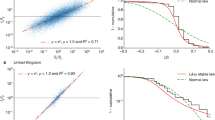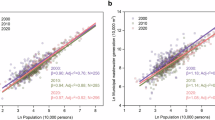Abstract
Africa is set to drive future global urbanization, yet the evolution of its urban systems remains underexplored. Here we show this evolution during 1950–2020 using three urban system rules based on a unified urban definition across the African continent. Zipf’s law quantified increasing population concentration in large cities, leading to a shift from dispersed to centralized city-size distributions. As Gibrat’s law predicted, urban population growth was independent of its initial size since the 1990s. Relative growth among different-sized cities changed urban hierarchy, thus the integration of Zipf’s and Gibrat’s laws uncovered imbalances in urban system structures. The third rule we focus on is the scaling law, where unexpected super-linear scaling relationships between built-up areas and population size indicated lower land-use efficiency in large cities, particularly in Eastern and Western Africa. However, the overall decline in built-up scaling exponents over time suggested improving economies of scale as urban systems matured. This study evidenced simple rules behind complex urban systems that help us understand broader urban complexities and urbanization dynamics.
This is a preview of subscription content, access via your institution
Access options
Subscribe to this journal
Receive 12 digital issues and online access to articles
118,99 € per year
only 9,92 € per issue
Buy this article
- Purchase on SpringerLink
- Instant access to full article PDF
Prices may be subject to local taxes which are calculated during checkout




Similar content being viewed by others
Data availability
The population and built-up areas of African urban agglomerations are publicly available from Africapolis (https://africapolis.org/en). The total urban population and urbanization level of Africa are from the World Population Prospects 2022 (https://population.un.org/wpp/). Macro socio-economic statistics at the country level, such as GDP per capita, are from the World Bank (https://data.worldbank.org/). The geospatial data of administrative boundaries for mapping are from the Global Administrative Areas (GADM; https://gadm.org/).
Code availability
Statistical analyses are performed using R programming (version 1.4.1717) and maps are drawn using ArcGIS (version 10.6). The R code is available on GitHub at https://github.com/xugang2016/african-urban-system.
References
Elmqvist, T. et al. Urbanization in and for the Anthropocene. npj Urban Sustain. 1, 6 (2021).
Yang, R. et al. Urban rooftops for food and energy in China. Nat. Cities 1, 741–750 (2024).
Bai, X. Post-2030 global goals need explicit targets for cities and businesses. Science 385, eadq4993 (2024).
World Cities Report 2022: Envisaging the Future of Cities (United Nations Research Institute for Social Development, 2022).
Cobbinah, P. B., Erdiaw-Kwasie, M. O. & Amoateng, P. Africa’s urbanisation: implications for sustainable development. Cities 47, 62–72 (2015).
OECD/SWAC Africa’s Urbanisation Dynamics 2020: Africapolis, Mapping a New Urban Geography (OECD Publishing, 2020).
Berry, B. J. Cities as systems within systems of cities. Pap. Reg. Sci. 13, 146–163 (1964).
Arcaute, E. & Ramasco, J. J. Recent advances in urban system science: models and data. PLoS ONE 17, e0272863 (2022).
Bettencourt, L. M. Introduction to Urban Science: Evidence and Theory of Cities as Complex Systems (MIT Press, 2021).
Lobo, J. et al. Urban science: integrated theory from the first cities to sustainable metropolises. Preprint at SSRN https://doi.org/10.2139/ssrn.3526940 (2020).
Acuto, M., Parnell, S. & Seto, K. C. Building a global urban science. Nat. Sustain. 1, 2–4 (2018).
Batty, M. The New Science of Cities (MIT Press, 2013).
Li, R. et al. Simple spatial scaling rules behind complex cities. Nat. Commun. 8, 1841 (2017).
Batty, M. The size, scale, and shape of cities. Science 319, 769–771 (2008).
Gabaix, X. Zipf’s law for cities: an explanation. Q. J. Econ. 114, 739–767 (1999).
Batty, M. Rank clocks. Nature 444, 592–596 (2006).
Eeckhout, J. Gibrat’s law for (all) cities. Am. Econ. Rev. 94, 1429–1451 (2004).
Verbavatz, V. & Barthelemy, M. The growth equation of cities. Nature 587, 397–401 (2020).
Bettencourt, L. M., Lobo, J., Helbing, D., Kuhnert, C. & West, G. B. Growth, innovation, scaling, and the pace of life in cities. Proc. Natl Acad. Sci. USA 104, 7301–7306 (2007).
Bettencourt, L. M. A. The origins of scaling in cities. Science 340, 1438–1441 (2013).
Lu, M., Zhou, C., Wang, C., Jackson, R. B. & Kempes, C. P. Worldwide scaling of waste generation in urban systems. Nat. Cities 1, 126–135 (2024).
West, G. B. Scale: The Universal Laws of Growth, Innovation, Sustainability, and the Pace of Lifein Organisms, Cities, Economies, and Companies (Penguin, 2017).
Keuschnigg, M., Mutgan, S. & Hedström, P. Urban scaling and the regional divide. Sci. Adv. 5, eaav0042 (2019).
Gomez-Lievano, A., Patterson-Lomba, O. & Hausmann, R. Explaining the prevalence, scaling and variance of urban phenomena. Nat. Hum. Behav. 1, 0012 (2016).
Arvidsson, M., Lovsjö, N. & Keuschnigg, M. Urban scaling laws arise from within-city inequalities. Nat. Hum. Behav. 7, 365–374 (2023).
Sahasranaman, A. & Bettencourt, L. M. Urban geography and scaling of contemporary Indian cities. J. R. Soc. Interface 16, 20180758 (2019).
Soo, K. T. Zipf, Gibrat and geography: evidence from China, India and Brazil. Pap. Reg. Sci. 93, 159–182 (2014).
Chauvin, J. P., Glaeser, E., Ma, Y. & Tobio, K. What is different about urbanization in rich and poor countries? Cities in Brazil, China, India and the United States. J. Urban Econ. 98, 17–49 (2017).
Bettencourt, L. & Marchio, N. Street access, informality and development: a block level analysis across all of sub-Saharan Africa. Preprint at https://arxiv.org/abs/2307.16328 (2023).
Prieto-Curiel, R., Patino, J. E. & Anderson, B. Scaling of the morphology of African cities. Proc. Natl Acad. Sci. USA 120, e2214254120 (2023).
Prieto Curiel, R., Cabrera-Arnau, C. & Bishop, S. R. Scaling beyond cities. Front. Phys. 10, 858307 (2022).
Xu, G. et al. Settlement scaling law reveals population-land tensions in 7000+ African urban agglomerations. Habitat Int. 142, 102954 (2023).
Xu, G. et al. Urban expansion and form changes across African cities with a global outlook: spatiotemporal analysis of urban land densities. J. Clean. Prod. 224, 802–810 (2019).
Dong, L. et al. Defining a city—delineating urban areas using cell-phone data. Nat. Cities 1, 117–125 (2024).
World Population Prospects 2022 (United Nations, Department of Economic and Social Affairs, Population Division, 2022).
Giesen, K., Zimmermann, A. & Suedekum, J. The size distribution across all cities—double Pareto lognormal strikes. J. Urban Econ. 68, 129–137 (2010).
Clauset, A., Shalizi, C. R. & Newman, M. E. Power-law distributions in empirical data. SIAM Rev. 51, 661–703 (2009).
Zhao, S. et al. Spatial and temporal dimensions of urban expansion in China. Environ. Sci. Technol. 49, 9600–9609 (2015).
Ning, Y. et al. Urban growth rates, trajectories, and multi-dimensional disparities in China. Cities 126, 103717 (2022).
Salem, M., Tsurusaki, N., Xu, X. & Xu, G. Revealing the transformation of spatial structure of greater Cairo: insights from satellite imagery and geospatial metrics. J. Urban Manage. 13, 565–579 (2024).
Cobbinah, P. B. & Gaisie, E. Reimagining Urban Planning in Africa (Cambridge Univ. Press, 2023).
Sumari, N. S. et al. A geospatial approach to sustainable urban planning: lessons for Morogoro Municipal Council, Tanzania. Sustainability 11, 6508 (2019).
Arcaute, E. et al. Constructing cities, deconstructing scaling laws. J. R. Soc. Interface 12, 20140745 (2015).
Cottineau, C., Hatna, E., Arcaute, E. & Batty, M. Diverse cities or the systematic paradox of urban scaling laws. Comput. Environ. Urban Syst. 63, 80–94 (2017).
Jia, M., Liu, Y., Lieske, S. N. & Chen, T. Public policy change and its impact on urban expansion: an evaluation of 265 cities in China. Land Use Policy 97, 104754 (2020).
Gomez-Lievano, A., Youn, H. & Bettencourt, L. M. The statistics of urban scaling and their connection to Zipf’s law. PLoS ONE 7, e40393 (2012).
Heinrigs, P. Africapolis: understanding the dynamics of urbanization in Africa. Field Actions Sci. Rep. Special Issue 22, 18–23 (2020).
Ades, A. F. & Glaeser, E. L. Trade and circuses: explaining urban giants. Q. J. Econ. 110, 195–227 (1995).
Gabaix, X. & Ibragimov, R. Rank − 1/2: a simple way to improve the OLS estimation of tail exponents. J. Bus. Econ. Stat. 29, 24–39 (2011).
González-Val, R., Ximénez-de-Embún, D. P. & Sanz-Gracia, F. A long-term, regional-level analysis of Zipf’s and Gibrat’s laws in the United States. Cities 149, 104946 (2024).
Succar, R. & Porfiri, M. Urban scaling of firearm violence, ownership and accessibility in the United States. Nat. Cities 1, 216–224 (2024).
Leitao, J. C., Miotto, J. M., Gerlach, M. & Altmann, E. G. Is this scaling nonlinear? R. Soc. Open Sci. 3, 150649 (2016).
Acknowledgements
This research was supported by the National Natural Science Foundation of China (42101460 to G.X., 42201373 to B.C. and 42371423 to L.J.), the International Science and Technology Cooperation Project of Hubei Province, China (2023EHA001 to G.X.), the Fundamental Research Funds for the Central Universities (2042024kf0004 to G.X.), the Natural Science Foundation of Hubei Province, China (JCZRYB202400503 to G.X.), the Research Grants Council of Hong Kong Early Career Scheme (HKU27600222 to B.C.) and General Research Fund (HKU17601423 to B.C. and HKU17307024 to P.G.), and the Croucher Foundation (CAS22902/CAS22HU01 to P.G.). The funders had no role in study design, data collection and analysis, decision to publish or preparation of the manuscript. We greatly appreciate the Africapolis project for providing the valuable dataset to understand urbanization in Africa.
Author information
Authors and Affiliations
Contributions
G.X., L.J. and P.G. designed the research framework. B.C., M.S. and Z.X. improved the research design. G.X. and M.Z. developed the algorithm, performed data analyses and wrote the draft. B.C., P.B.C., X.L., N.S.S. and X.Z. analyzed and interpreted the results. All authors contributed to editing the paper.
Corresponding authors
Ethics declarations
Competing interests
The authors declare no competing interests.
Peer review
Peer review information
Nature Cities thanks Rafael Prieto-Curiel, Ivan Turok and the other, anonymous, reviewer(s) for their contribution to the peer review of this work.
Additional information
Publisher’s note Springer Nature remains neutral with regard to jurisdictional claims in published maps and institutional affiliations.
Supplementary information
Supplementary Information
Supplementary Text, Figs. 1–10 and Tables 1–4.
Rights and permissions
Springer Nature or its licensor (e.g. a society or other partner) holds exclusive rights to this article under a publishing agreement with the author(s) or other rightsholder(s); author self-archiving of the accepted manuscript version of this article is solely governed by the terms of such publishing agreement and applicable law.
About this article
Cite this article
Xu, G., Zhu, M., Chen, B. et al. Underlying rules of evolutionary urban systems in Africa. Nat Cities 2, 327–335 (2025). https://doi.org/10.1038/s44284-025-00208-y
Received:
Accepted:
Published:
Issue Date:
DOI: https://doi.org/10.1038/s44284-025-00208-y



